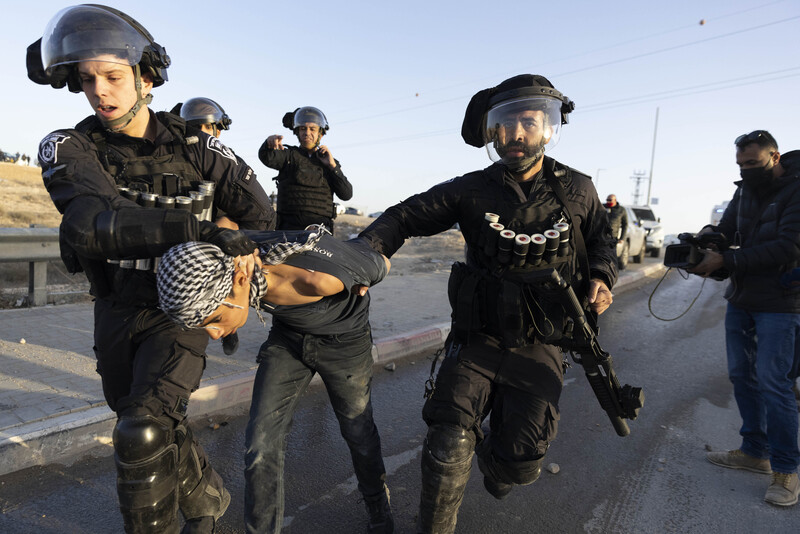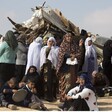The Electronic Intifada 23 February 2022

Israeli forces seize a Palestinian youth at a protest against a Jewish National Fund afforestation project that would displace Bedouins from their land in the Naqab, near the village of Sawa al-Atrash on 13 January 2022.
ActiveStillsThe first of this month, Amnesty International issued a report that declared Israel an apartheid regime.
Whether Palestinians live in the besieged Gaza Strip, in East Jerusalem and the rest of the occupied West Bank, or within Israel itself, Israel treats them as an inferior racial group and deprives them of their rights.
The report highlighted the southern Naqab (Negev) region as a “prime example” of Israel’s long-standing policy to appropriate Palestinian land and resources to benefit Jewish Israelis.
Weeks before the publication of the Amnesty report, Palestinian Bedouins in the Naqab had been resisting renewed Israeli attempts to expropriate large swathes of land under the guise of “afforestation.”
Last month, Israeli forces cracked down on protesters, fired rubber-coated steel bullets and dropped tear gas canisters using drones. Dozens of Palestinians were injured and Israeli authorities reportedly detained more than 80.
Israeli police also fired sponge-tipped steel bullets against protesters, injuring five in the head, Haaretz reported.
One Palestinian teen, who was a bystander at the protests, lost an eye after Israeli police shot at him.
The Jewish National Fund and the Israel Land Authority are seeking to expropriate more than 11,000 acres of Palestinian land to plant trees, Al Jazeera reported.
But Palestinian Bedouins know Israel has long used “afforestation” as a way to seize lands in the Naqab and elsewhere, and to hide the landmarks and ruins of Palestinian villages after Israel destroyed and ethnically cleansed them.
It is Israel’s signature method of erasing all traces of its crime.
Judaizing the Naqab
Israel has adopted various policies to “Judaize” the Naqab since 1948, most notably designating large areas as nature reserves, and industrial and military firing zones around Bedouin villages, as noted by Amnesty.
Israel corralled Bedouin residents and forcefully transferred them to what it called “planned townships.”
This has had devastating consequences for the Palestinian Bedouins who live in the area.
Israel still refuses to recognize 35 Bedouin villages in the Naqab, thus cutting them off from electricity and water supplies and targeting them for demolition, Amnesty reported.
In December, Israeli occupation authorities demolished the Bedouin village of al-Araqib in the northern Naqab desert for nearly the 200th time since the year 2000.
Palestinians have repeatedly rebuilt the village only to endure Israel demolishing it again, under the pretext that it is unrecognized.
By refusing to grant villages official status, Israel limits Bedouin residents’ political participation and excludes them from healthcare and education systems. This is designed to coerce them to leave their homes and villages, i.e. forcibly transferring them.
Israel demolished more than 10,000 homes in the Naqab between 2013 and 2019, according to Human Rights Watch.
In 2013, the Knesset, Israel’s parliament, approved the so-called Prawer Plan, designed to forcibly displace residents of dozens of Palestinian villages in the Naqab and concentrate them in a segregated area.
Under this law, Israel would have forcibly displaced 70,000 Bedouins from the area. The 35 unrecognized villages would be demolished.
For now, popular protests and the condemnations of many international bodies have forced the government of Israel to suspend implementation of the plan.
These projects are designed to drive Palestinians out of the region and replace them with Jewish Israelis.
Naqab as ongoing Nakba
Since it was founded on the ruins of Palestinian cities and villages in 1948, Israel’s strategic colonial goal has been to steal Palestinian land and forcibly displace its native population.
From the far north of the Galilee to the southern Naqab, and all around the occupied West Bank, including East Jerusalem, Israel continues to pursue this goal.
As Israeli forces attacked protesters in the Naqab last month, occupation bulldozers demolished the Salhiya family’s home on a cold and rainy night in the Sheikh Jarrah neighborhood of occupied East Jerusalem, leaving the family homeless.
Residents of the Naqab recognize the national significance of their cause. The plight they face is the same one endured by the entire Palestinian people.
Some have named Israel’s crackdown and forced displacement of Palestinians in the Naqab as a smaller-scale version of the Nakba, the 1948 ethnic cleansing of nearly 800,000 Palestinians to make way for Israel.
“They treat us like refugees in our own land,” Palestinian activist Aden Hajjouj told media in the Naqab last month with revolutionary ardor.“This is not their land, this is ours. We have been here [since] before 1948, before Israel became Israel.”
Collective national identity
Amnesty’s apartheid designation follows that of Israeli human rights group B’Tselem and Human Rights Watch last year.
These reports alarm Israel because they undercut the false image it tries to project to the world.
Israel’s designation as an apartheid state shifts the focus from a tunnel-vision view of the conflict within the occupied West Bank and Gaza to seeing the problem in the very essence of Israel.
As Amnesty reports: “Since its establishment in 1948, Israel has pursued an explicit policy of establishing and maintaining a Jewish demographic hegemony and maximizing its control over land to benefit Jewish Israelis while minimizing the number of Palestinians and restricting their rights and obstructing their ability to challenge this dispossession.”
Palestinians, then, are rejecting a racial state.
Since its founding, Israel sought to separate the Palestinian people and fragment their national identity. Palestinian citizens of Israel are those who survived the Nakba of 1948 – and their descendants – and were able to remain in what became Israel.
Depending on where they are geographically, Israel classified Palestinians through a hierarchy of identifications with political, security and legal implications.
This separation was enforced through the signing of the Oslo accords between Israel and the Palestine Liberation Organization in the mid-1990s.
Although Israel’s repressive tools differ according to Palestinians’ legal and geographical classification, the essence of the repression is the same: expulsion, displacement and racial discrimination against Palestinians.
Israel hoped that such divisions would lead to a rift within Palestinian national consciousness against settler-colonialism.
The Israeli government never sought to integrate its Palestinian citizens, who make up 20 percent of the country’s population. Though these Palestinians are considered official Israeli citizens, Israel subjects them to ethnic and religious persecution.
Successive Israeli governments have legislated dozens of laws on issues of land, housing, building, education and work. These laws discriminate against Palestinian citizens of Israel, rob them of their civil rights, confiscate their lands and restrict their public space.
Israel’s systematic racial discrimination against the Palestinians in the vast territory occupied in 1948 contributed to the growth of Palestinian patriotism.
That Palestinian patriotism, partly suppressed for decades within modern-day Israel, was recaptured in May 2021 as Palestinians widely protested the Israeli military’s assault on Gaza and Israel’s encroachment on Sheikh Jarrah.
As Amnesty International states in the executive summary to its apartheid report, “In a display of unity not seen for decades, [Palestinians] defied the territorial fragmentation and segregation they face in their daily lives and observed a general strike to protest their shared repression by Israel.”
That unity, from the Naqab in the south to the Galilee in the north, Gaza and the West Bank, is essential to moving off the failed two-state model – that does not secure all Palestinian rights – and galvanizing Palestinians toward a movement for one state that upholds key principles such as equal rights and the right of return.
Ahmed Abu Artema is a Palestinian writer and activist who is a refugee from Ramle.




